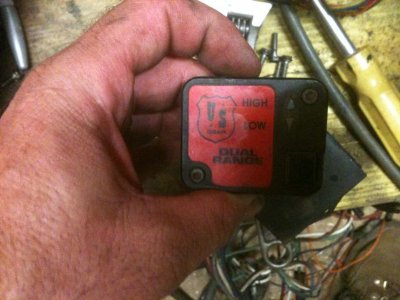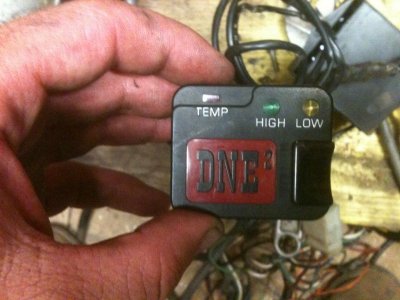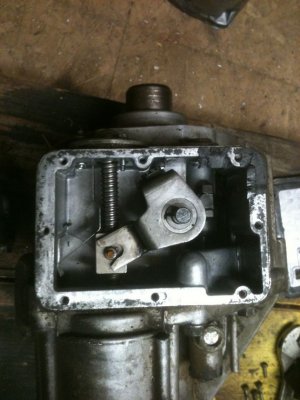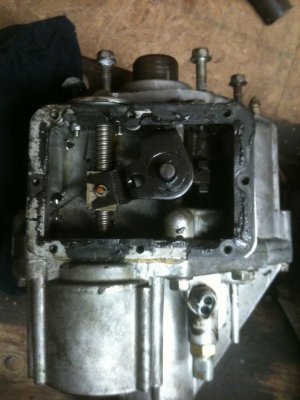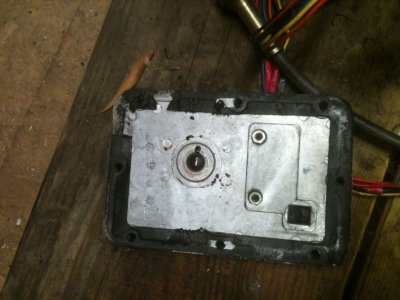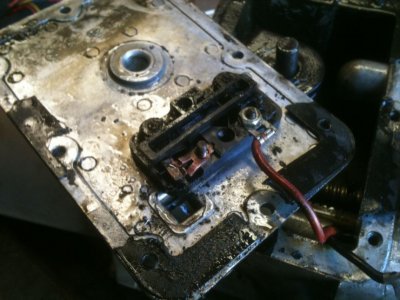jaluhn83
Full Access Member
Since there seems to be a number of different places for info on these, I'm starting this thread to try and consolidate it all in one spot. We'll see how it works...
Both the US Gear Dual Range and Doug Nash DNE2 boxes are designed as add on 2 speed auxiliary gear boxes useful for either a higher top gear, lower bottom gear and/or gear splitting. They are a very heavy duty quad countershaft constant mesh mechanical shift type transmission similar in design to a standard truck transmission. This is contrast to the Gear Vendor / Laylock gearboxes which use a hydraulically shifted planetary design with a clutch. More on that later.
The US Gear and the DNE2 are essentially the same box. Doug Nash was the original manufacturer and then it was taken over by US Gear sometime in the early 90's. There are apparently 2 different designs of the DNE2, and possibly 2 different US Gear generations as well. The difference between the 2 appear to be mainly in the shift mechanism / controls, and there is reportedly a difference in gear helix angle however I am not sure exactly when this change occurred.
Both units were available in an overdrive or underdrive configuration. That is, you'll have either 1.25:1/1:1 or 0.8:1/1:1 - can't get over/under in the same box. Unfortunately, the only reliable way to tell which is to mark each shaft and count turns. You can shift the box without any controls by jumpering the case to ground and connecting one or the other of the terminals on the flat side of the box to +12 volts. If it's a US Gear box it should run until you remove power (2 seconds should be long enough to shift) and if it a DNE2 it should stop automatically. You may or may not be able to hear it actually shift, so try one way, check the ratio then try the other way and check again.
The US Gear is rated for a GCWV of 35,000 lb and I expect the DNE2 to be similar though I have no specs.
Some info:
http://www.racingjunk.com/manufacturersshowcase/USGearDualRangeAuxilliaryTransmission
Sadly, US Gear is no longer making these and the new owner has no interest in any for of support. Luckily, most wear parts appears to be fairly easy to get.
Both type boxes were sold in 2wd and 4wd configuration, that 4wd seems much rarer. The 4wd config mounts between the trans & t-case. The front flange on these units is essentially the same size as the standard Ford transfer case, but it is clocked ~30* and you cannot directly bolt one up to a 4wd trans due not only to the clocking, but also shaft length and the alignment pin on the rear of the trans. There was a ~3/4" thick adapter used stock which would be relatively easy to fabricate. Towcat has done this and has the drawing, but one would have to talk to him to get a copy and I understand his experience was that it was fairly expensive. In the 4wd application the t-case bolts directly onto the back of the DNE2/USG box. In the 2wd configuration there is an adapter that replaces the trans rear housing. For the C6 application the box fits directly on the existing trans output shaft, but for the T18/19 there is a special adapter shaft also needed most likely due to the trans design. (I suspect the output yoke bolt also hold rear bearing or other parts in so you can't just have a floating shaft) I am unsure how other transmissions install.
There were a number of input shaft configurations available to fit different transmissions - most of our should be a 31 spline. It appears that the 2WD T18/19 adapter setup actually requires a 32 spline Dual Range input but I have not verified this. If so, then the 32 spline GM/Dodge units would also fit the T18/19 (assuming you have the T-18/19 adapter setup already)
Conversion from one input/output shaft type, under/overdrive or 2/4wd is possible, but not easy. The input/ouput shafts are part of the input/output gears so you need that entire part and would need to make sure the gearing matched the current, plus checking backlash and end play. Over/under sear conversion would require swapping the entire gearset. 2/4wd conversion would require a different rear case half & output shaft/gear. All things considered it's not very practical.
Because this is a positive engagement mechanically shifted unit, it can be shifted at any speed and will remain in that gear until shifted again. This is in contrast to the Gear Vendors, where you must be going above a certain speed to shift and it will always return to direct drive when stopped. This allows the Dual Range to be much more useful as a gear splitter and IMHO makes it much more reliable - no clutches or oil pumps to wear.
The weak spot in this system is the shift mechanism / motor. However, it's not that catastrophic of a problem. This mechanism is more or less directly copied from that used on the common medium duty 2 speed rear axle - it uses a reversible 3 wire electric motor to turn a lead screw in turn loading a spring which connects to the shift yoke. The use of the spring controls load on the motor and also allows for a crisp shift - torque on the gears will hold it in the current gear until the driver unloads the gear train through letting off the throttle, shifting the main trans or pushing in the clutch at which point the spring will quickly shift the box minimizing wear and making it easy to control.
One reported common issue with these is drivers not allowing the spring to load - you much hit the switch then wait 2+ seconds for preload, then relax the drivetrain. Reportedly not doing this causes the shift motor to take the shifting load causing overloading and potential motor damage.
One major difference between the DNE & US Gear setups is the method of shift control. The motor has 2 different coils with 2 different positive leads (one for each direction) tied to a common ground through the casing. These 2 leads connect to the round terminals on the flat side of the case and the ground goes through the case. To shift one way, all you need to do is apply power to one of those 2 terminals, and likewise apply power to the other to shift the other way. The leadscrew is setup with an overrunning stop at each end so once it reaches the end of its travel it'll stop moving but the screw continues to rotate without stalling or moving until power is cutoff to the motor.
The DNE2 uses a stop switch under the cover to control this power cutoff whereas the US Gear does it electronically. The DNE2 setup is the same as many 2 speed rear ends.
The switch looks like this: http://www.summitracing.com/parts/smp-ds169?seid=srese1&gclid=CM_msZOZwbkCFS3hQgodnRkAmw
There's a pin on the leadscrew block that hooks into the black rectangular bar in the center - this is spring loaded to one end or the other and is setup to open one of the switch bars and close the other each time it moves back and forth. (very simple in operation but harder to describe.) The terminals on the outside of the case connect to the pivot end of each blade, and the motor terminals to the 2 terminals on the face. Assuming you put power to the outside terminal which has a closed blade switch, power flows to the motor causing it to rotate and move the shifter until it moves far enough to flip the bar to the other end opening that blade switch and closing the other resulting in power being cutoff to the motor and the connection made for power to flow through the other blade to shift back.
The advantage of this setup is the external controls are very simple. At the easiest all you'd need is a 2 position 3 wire switch - same as a 2 speed axle. With the cutout switch built in to the gearbox all you need to do is put power to alternate terminals on the case. The disadvantage is that a mechanical failure of the cutout switch (ie broken plastic) will make the motor continue to run causing either wear on the leadscrew or a burnt out motor.
The later US Gear setup uses an external electronic controller that is nothing more than a timer and a pair of relays setup to apply 12 volts to alternate terminals for ~2 seconds. Without the cutout switch you need an external control to shut off the power. The circuit to do this is fairly simple but would require some decent electronic skills. Alternately you could wire it with a SPDT momentary switch and just hold the switch for ~2 seconds.
The 2 other switches located on the rear of the case are nothing more than indicator switches that control the 'hi' and 'low' indicator lights - they have no connection to the controls. These are simple indicator switches that close when the unit actually shifts gears.
The OEM DNE2 automatic trans control uses a pushbutton control that switches a relay - similar setup to the hi/lo beam control on many cars. In fact, the relay used appears to be a Nissan headlight relay!
Generally these units appear to be highly reliable. The most common problem seems to be failure of the shift motor / control switch. The control switch appears to be fairly easy to get (see the link above, also available from rockauto). This switch looks correct but I'm not 100% sure it'd fit. I have also found 2 speed rear axle shift motors (four seasons 33521, etc) that appear similar but I have not verified that these actual fit either. Mechanical parts seem to be fairly standard transmission parts though I have no part numbers or other info at this time.
Other references:
http://www.oilburners.net/forums/showthread.php?65141-US-Gear-vs-Doug-Nash-amp-4WD-Commonality&highlight=doug+nash+overdrive
http://www.oilburners.net/forums/showthread.php?39326-It-followed-me-home-can-I-keep-it/page1
http://www.oilburners.net/forums/showthread.php?57404-US-Gear-Dual-Range-Doug-Nash-Manual&highlight=dual+range
http://www.oilburners.net/forums/showthread.php?57815-US-Gear-Dual-Range-Reliability&highlight=dual+range
Manuals (coutesy of The Warden)
http://www.dieselwarden.net/temp/usgear/US%20Gears%20overdrive%20manual.pdf
http://www.dieselwarden.net/temp/usgear/Dual%20Range.pdf
http://www.dieselwarden.net/temp/usgear/U.S.%20Gear%20DR%20Elec%20Install.htm
http://www.dieselwarden.net/temp/usgear/U.S.%20Gear%20DR%20Elec%20Troubleshoot.htm
Both the US Gear Dual Range and Doug Nash DNE2 boxes are designed as add on 2 speed auxiliary gear boxes useful for either a higher top gear, lower bottom gear and/or gear splitting. They are a very heavy duty quad countershaft constant mesh mechanical shift type transmission similar in design to a standard truck transmission. This is contrast to the Gear Vendor / Laylock gearboxes which use a hydraulically shifted planetary design with a clutch. More on that later.
The US Gear and the DNE2 are essentially the same box. Doug Nash was the original manufacturer and then it was taken over by US Gear sometime in the early 90's. There are apparently 2 different designs of the DNE2, and possibly 2 different US Gear generations as well. The difference between the 2 appear to be mainly in the shift mechanism / controls, and there is reportedly a difference in gear helix angle however I am not sure exactly when this change occurred.
Both units were available in an overdrive or underdrive configuration. That is, you'll have either 1.25:1/1:1 or 0.8:1/1:1 - can't get over/under in the same box. Unfortunately, the only reliable way to tell which is to mark each shaft and count turns. You can shift the box without any controls by jumpering the case to ground and connecting one or the other of the terminals on the flat side of the box to +12 volts. If it's a US Gear box it should run until you remove power (2 seconds should be long enough to shift) and if it a DNE2 it should stop automatically. You may or may not be able to hear it actually shift, so try one way, check the ratio then try the other way and check again.
The US Gear is rated for a GCWV of 35,000 lb and I expect the DNE2 to be similar though I have no specs.
Some info:
http://www.racingjunk.com/manufacturersshowcase/USGearDualRangeAuxilliaryTransmission
Sadly, US Gear is no longer making these and the new owner has no interest in any for of support. Luckily, most wear parts appears to be fairly easy to get.
Both type boxes were sold in 2wd and 4wd configuration, that 4wd seems much rarer. The 4wd config mounts between the trans & t-case. The front flange on these units is essentially the same size as the standard Ford transfer case, but it is clocked ~30* and you cannot directly bolt one up to a 4wd trans due not only to the clocking, but also shaft length and the alignment pin on the rear of the trans. There was a ~3/4" thick adapter used stock which would be relatively easy to fabricate. Towcat has done this and has the drawing, but one would have to talk to him to get a copy and I understand his experience was that it was fairly expensive. In the 4wd application the t-case bolts directly onto the back of the DNE2/USG box. In the 2wd configuration there is an adapter that replaces the trans rear housing. For the C6 application the box fits directly on the existing trans output shaft, but for the T18/19 there is a special adapter shaft also needed most likely due to the trans design. (I suspect the output yoke bolt also hold rear bearing or other parts in so you can't just have a floating shaft) I am unsure how other transmissions install.
There were a number of input shaft configurations available to fit different transmissions - most of our should be a 31 spline. It appears that the 2WD T18/19 adapter setup actually requires a 32 spline Dual Range input but I have not verified this. If so, then the 32 spline GM/Dodge units would also fit the T18/19 (assuming you have the T-18/19 adapter setup already)
Conversion from one input/output shaft type, under/overdrive or 2/4wd is possible, but not easy. The input/ouput shafts are part of the input/output gears so you need that entire part and would need to make sure the gearing matched the current, plus checking backlash and end play. Over/under sear conversion would require swapping the entire gearset. 2/4wd conversion would require a different rear case half & output shaft/gear. All things considered it's not very practical.
Because this is a positive engagement mechanically shifted unit, it can be shifted at any speed and will remain in that gear until shifted again. This is in contrast to the Gear Vendors, where you must be going above a certain speed to shift and it will always return to direct drive when stopped. This allows the Dual Range to be much more useful as a gear splitter and IMHO makes it much more reliable - no clutches or oil pumps to wear.
The weak spot in this system is the shift mechanism / motor. However, it's not that catastrophic of a problem. This mechanism is more or less directly copied from that used on the common medium duty 2 speed rear axle - it uses a reversible 3 wire electric motor to turn a lead screw in turn loading a spring which connects to the shift yoke. The use of the spring controls load on the motor and also allows for a crisp shift - torque on the gears will hold it in the current gear until the driver unloads the gear train through letting off the throttle, shifting the main trans or pushing in the clutch at which point the spring will quickly shift the box minimizing wear and making it easy to control.
One reported common issue with these is drivers not allowing the spring to load - you much hit the switch then wait 2+ seconds for preload, then relax the drivetrain. Reportedly not doing this causes the shift motor to take the shifting load causing overloading and potential motor damage.
One major difference between the DNE & US Gear setups is the method of shift control. The motor has 2 different coils with 2 different positive leads (one for each direction) tied to a common ground through the casing. These 2 leads connect to the round terminals on the flat side of the case and the ground goes through the case. To shift one way, all you need to do is apply power to one of those 2 terminals, and likewise apply power to the other to shift the other way. The leadscrew is setup with an overrunning stop at each end so once it reaches the end of its travel it'll stop moving but the screw continues to rotate without stalling or moving until power is cutoff to the motor.
The DNE2 uses a stop switch under the cover to control this power cutoff whereas the US Gear does it electronically. The DNE2 setup is the same as many 2 speed rear ends.
The switch looks like this: http://www.summitracing.com/parts/smp-ds169?seid=srese1&gclid=CM_msZOZwbkCFS3hQgodnRkAmw
There's a pin on the leadscrew block that hooks into the black rectangular bar in the center - this is spring loaded to one end or the other and is setup to open one of the switch bars and close the other each time it moves back and forth. (very simple in operation but harder to describe.) The terminals on the outside of the case connect to the pivot end of each blade, and the motor terminals to the 2 terminals on the face. Assuming you put power to the outside terminal which has a closed blade switch, power flows to the motor causing it to rotate and move the shifter until it moves far enough to flip the bar to the other end opening that blade switch and closing the other resulting in power being cutoff to the motor and the connection made for power to flow through the other blade to shift back.
The advantage of this setup is the external controls are very simple. At the easiest all you'd need is a 2 position 3 wire switch - same as a 2 speed axle. With the cutout switch built in to the gearbox all you need to do is put power to alternate terminals on the case. The disadvantage is that a mechanical failure of the cutout switch (ie broken plastic) will make the motor continue to run causing either wear on the leadscrew or a burnt out motor.
The later US Gear setup uses an external electronic controller that is nothing more than a timer and a pair of relays setup to apply 12 volts to alternate terminals for ~2 seconds. Without the cutout switch you need an external control to shut off the power. The circuit to do this is fairly simple but would require some decent electronic skills. Alternately you could wire it with a SPDT momentary switch and just hold the switch for ~2 seconds.
The 2 other switches located on the rear of the case are nothing more than indicator switches that control the 'hi' and 'low' indicator lights - they have no connection to the controls. These are simple indicator switches that close when the unit actually shifts gears.
The OEM DNE2 automatic trans control uses a pushbutton control that switches a relay - similar setup to the hi/lo beam control on many cars. In fact, the relay used appears to be a Nissan headlight relay!
Generally these units appear to be highly reliable. The most common problem seems to be failure of the shift motor / control switch. The control switch appears to be fairly easy to get (see the link above, also available from rockauto). This switch looks correct but I'm not 100% sure it'd fit. I have also found 2 speed rear axle shift motors (four seasons 33521, etc) that appear similar but I have not verified that these actual fit either. Mechanical parts seem to be fairly standard transmission parts though I have no part numbers or other info at this time.
Other references:
http://www.oilburners.net/forums/showthread.php?65141-US-Gear-vs-Doug-Nash-amp-4WD-Commonality&highlight=doug+nash+overdrive
http://www.oilburners.net/forums/showthread.php?39326-It-followed-me-home-can-I-keep-it/page1
http://www.oilburners.net/forums/showthread.php?57404-US-Gear-Dual-Range-Doug-Nash-Manual&highlight=dual+range
http://www.oilburners.net/forums/showthread.php?57815-US-Gear-Dual-Range-Reliability&highlight=dual+range
Manuals (coutesy of The Warden)
http://www.dieselwarden.net/temp/usgear/US%20Gears%20overdrive%20manual.pdf
http://www.dieselwarden.net/temp/usgear/Dual%20Range.pdf
http://www.dieselwarden.net/temp/usgear/U.S.%20Gear%20DR%20Elec%20Install.htm
http://www.dieselwarden.net/temp/usgear/U.S.%20Gear%20DR%20Elec%20Troubleshoot.htm

